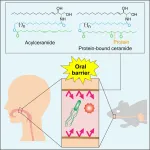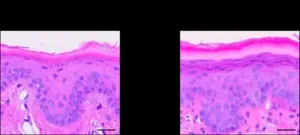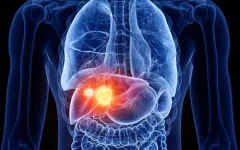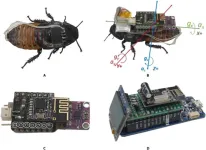(Press-News.org) Acylceramides and protein-bound ceramides are vital for the formation of the oral barrier in mice, similar to their role in skin, protecting from infection.
The skin is the body’s first line of defense against the environment, particularly against pathogens, chemicals, and allergens. It is now known that a class of biological molecules called acylceramides and their metabolites, protein-bound ceramides, are essential to the formation of this barrier. The outermost tissues of the mouth are closely related to the skin and have similar functions—an oral barrier. However, little is known about the role and importance of acylceramides and protein-bound ceramides in the oral barrier.
Associate Professor Takayuki Sassa and Professor Akio Kihara at the Faculty of Pharmaceutical Sciences, Hokkaido University, investigated the roles of acylceramides and protein-bound ceramides in the formation of the oral barrier in mice. Their findings, published in the journal Cell Reports, reveal that acylceramides and protein-bound ceramides are indispensable for the formation of the oral barrier.
“The skin and the tissues of the mouth and throat are classified as a type of tissue called stratified squamous epithelium; acylceramides and protein-bound ceramides are present in both,” Sassa explained. “These ceramides in the skin are vital as they create the permeability barrier. Hence, we were interested in investigating if they played a similar role in the formation of the oral barrier.”
Sassa and Kihara first performed liquid chromatography-tandem mass spectrometry analyses, to fully understand the types of acrylamides and protein-bound ceramides present in the mouse oral tissues. To examine the role and importance of acylceramides and protein-bound ceramides, they generated model mice, which have reduced ability to synthesize these ceramides in the oral tissues.
The tongues of mice having less acylceramides and protein-bound ceramides exhibited hyperkeratosis, the thickening of the outermost layer, often observed in the skin with barrier deficiency, and the mice were significantly more sensitive to capsaicin in drinking water, indicating that the oral barrier formation was affected.
In addition, using oral swabs collected from three volunteers, they also analyzed and cataloged the acylceramides and protein-bound ceramides present in the human oral tissues.
“We conclusively demonstrated that acylceramides and protein-bound ceramides were present in the oral tissues,” Kihara expounded. “This was highlighted in the model mice we developed for the study: due to the reduction in the amount of acylceramides and protein-bound ceramides, oral barrier formation was affected.”
While the findings of the study that acylceramides and protein-bound ceramides are vital for the formation of the oral barrier in mice, this must be confirmed in humans. In particular, the soft and hard tissues of the human mouth have different distributions of protein-bound ceramides, which may in turn affect the formation of the oral barrier at different locations.
END
Oral barrier is similar in ceramide composition to skin barrier
2023-04-12
ELSE PRESS RELEASES FROM THIS DATE:
How did Earth get its water?
2023-04-12
Washington, DC—Our planet’s water could have originated from interactions between the hydrogen-rich atmospheres and magma oceans of the planetary embryos that comprised Earth’s formative years, according to new work from Carnegie Science’s Anat Shahar and UCLA’s Edward Young and Hilke Schlichting. Their findings, which could explain the origins of Earth’s signature features, are published in Nature.
For decades, what researchers knew about planet formation was based ...
Effect of smartphone app home monitoring after oncologic surgery on quality of recovery
2023-04-12
About The Study: In this randomized clinical trial, postoperative follow-up for patients undergoing breast reconstruction and gynecologic oncology surgery using smartphone app–assisted monitoring led to improved quality of recovery and equal satisfaction with care compared with conventional in-person follow-up.
Authors: Claire Temple-Oberle, M.D., M.Sc., of the University of Calgary in Calgary, Alberta, Canada, is the corresponding author.
To access the embargoed study: Visit our For The Media website at this link https://media.jamanetwork.com/
(doi:10.1001/jamasurg.2023.0616)
Editor’s ...
Taking a placebo improves adherence to treatment for opioid use disorder, study finds
2023-04-12
Substance use disorder affects 20 million Americans, and more than 100,000 people died from a drug overdose in 2021, according to the Centers for Disease Control and Prevention. While the medication methadone has the strongest evidence-based effectiveness to prevent relapse, about half of patients drop out of their treatment within one year of initiation. The solution could lie in taking a simple “sugar pill” or placebo along with the methadone, according to a randomized clinical trial led by researchers at the University of Maryland School of Medicine.
In a randomized ...
New study flips the script on liver cancer
2023-04-12
Liver cancer is the third leading cause of cancer death and the sixth most common cancer type worldwide. Major risk factors include environmental and metabolic stressors, such as obesity, viral hepatitis and steatohepatitis (fatty and inflamed liver).
These stressors damage the liver by killing hepatocytes, the major cell type in the liver. The cell death then triggers an inflammatory response which signals the liver to generate a new batch of hepatocytes. But this sudden push towards cellular proliferation also increases the risk of tumor formation.
In ...
SWOG S2302 Pragmatica-Lung study opens to enrollment, a model for easier, more representative clinical trials
2023-04-12
A clinical trial that breaks new ground with its dramatically streamlined design and unusually broad eligibility criteria is now opening and available to patients with stage 4 or recurrent non-small cell lung cancer at cancer treatment clinics all across the United States.
The S2302 Pragmatica-Lung trial, developed and led by the SWOG Cancer Research Network, a clinical trials group funded by the National Cancer Institute (NCI), is designed to be easier for institutions to open and run and with few limits on eligibility, making it available to a larger group of patients with advanced non-small cell lung ...
Researchers reveal stability origin of Dion-Jacobson 2D perovskites
2023-04-12
Yin-Yang theory is an ancient Chinese philosophy in which Yin-Yang forces are interdependent and work in opposition to each other to create balance.
Recently, inspired by this ancient theory, a research team led by Prof. GUO Xin and Prof. LI Can from the Dalian Institute of Chemical Physics (DICP) of the Chinese Academy of Sciences (CAS) has revealed the origin of the stability of Dion–Jacobson (DJ) phase two-dimensional (2D) perovskite materials.
Their findings were published in Joule on April 12.
DJ 2D perovskites, a class of organic–inorganic ...
Scientists track evolution of microbes on the skin’s surface
2023-04-12
CAMBRIDGE, MA -- Human skin is home to millions of microbes. One of these microbes, Staphylococcus aureus, is an opportunistic pathogen that can invade patches of skin affected by eczema, also known as atopic dermatitis.
In a new study, researchers at MIT and other institutions have discovered that this microbe can rapidly evolve within a single person’s microbiome. They found that in people with eczema, S. aureus tends to evolve to a variant with a mutation in a specific gene that helps it grow faster on the skin.
This study marks ...
NCCN Annual Conference brings up important questions for improving cancer care
2023-04-12
PLYMOUTH MEETING, PA [April 12, 2023] — The NCCN 2023 Annual Conference took place in-person in Orlando and virtually, with a particular focus on human connection. That connection was underscored with more than 2,000 registrants from across the continuum of cancer care, including approximately 1,000 who returned in-person for the first time since 2019. Educational sessions highlighted the importance of ensuring care meets the latest standards while also rejecting a one-size-fits-all approach.
“At NCCN, we don’t shy away from difficult discussions; we want our conference attendees to take away the message that ...
Insilico Medicine successfully discovered potent, selective, and orally bioavailable small-molecule inhibitor of CDK8 using generative AI
2023-04-12
Insilico Medicine (“Insilico”), a clinical-stage generative artificial intelligence (AI)-driven drug discovery company, today announced that it has successfully discovered a potent, selective, and orally bioavailable small molecule inhibitor of CDK8 for the treatment of cancer using a structure-based generative chemistry approach enabled by the Chemistry42 multi-modal generative reinforcement learning platform. The research was published in the American Chemical Society’s Journal of Medicinal Chemistry, a leading journal in medicinal chemistry.
As members of the CDK family, CDK8 and its paralog protein CDK19 play critical roles in regulating transcription of ...
Movement optimization for a cyborg cockroach in a bounded space incorporating machine learning
2023-04-12
Have you ever wondered why some insects like cockroaches prefer to stay or decrease movement in darkness? Some may tell you it’s called photophobia, a habit deeply coded in their genes. A further question would be whether we can correct this habit of cockroaches, that is, moving in the darkness just as they move in bright backgrounds. Scientists from Osaka University may have answered this question with a positive answer. They solved this question by converting a cockroach into a cyborg. They published this research in the journal Cyborg and Bionic Systems. ...






